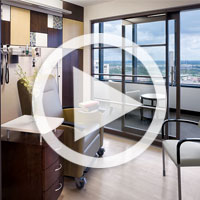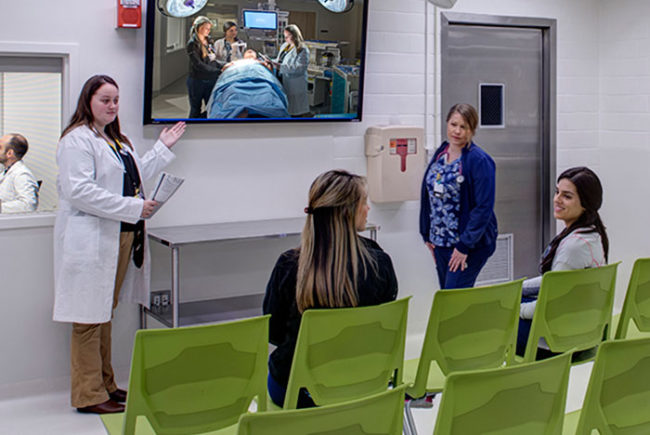
View "Forward-focused furnishings" Gallery
Evidence-based design, the use of credible research as a basis for design decisions, has become a standard approach to health facility design and construction.
According to the Center for Health Design, a Concord, Calif.-based research, education and advocacy group that works to advance best practices in health facility planning and design, more than 1,200 studies have linked the design of the built environment to health care quality and outcomes.
By understanding health care processes and creating environments to support patient care, designers can help to prevent conditions that lead to adverse effects, says Laurie Waggener, RRT, IIDA, AAHID, EDAC, research and evidence-based design leader, WHR Architects Inc., Houston.
“The hospital is not only a place to get well, it’s a place of work. And it’s very important work,” Waggener says. To reduce incidents of human error or health care-associated conditions, health care designers need to continue to explore as many domains of research as possible, including social science, ergonomics, human factors and neuroscience, she says.
Real-world solutions
Evidence-based design uses this information to solve real-world problems in facility design. For example, at Ocean Medical Center, Brick, N.J., the emergency department (ED) was outdated, undersized and did not meet the needs of behavioral health patients as well as the hospital wanted. Supplies and equipment could not be accessed quickly, which created patient safety issues and frustrated staff members about their workplace.
In creating the new Hirair and Anna Hovnanian Emergency Care Center for the hospital, WHR designers gathered data from front-line practitioners at the hospital and used that data to create a hierarchy of needs for ED supplies and equipment. Items used with every patient are wall-mounted in the same location in exam rooms wherever possible. Alcoves were created adjacent to exam rooms to store equipment and supplies ranked on the next level of the hierarchy.
Since studies have shown that natural light improves the healing environment, clerestory windows are included in the behavioral health holding rooms of the ED. This design provides the benefits of natural light to these patients while meeting behavioral health code requirements. WHR plans to study the effects of natural light in the private behavioral health rooms using incidents of restraint use and incidents of violence as measures.
Private rooms replaced the previous ward design, to give behavioral health patients more personal space. Nurse stations are located near the rooms, as research indicates this arrangement reduces patient anxiety. To address safety concerns, a dedicated off-stage corridor leads staff out of the unit in the event they feel unsafe.
The No. 1 goal in the design of an outpatient center at Houston Methodist Hospital was to enhance the patient experience. Natural light played a role in this project, too. Waggener describes the floor plan as bringing in “as much natural light as possible.” The infusion center features a glass bay with an adjacent balcony. Patients are given a choice of infusion settings, from a private space with a porchlike area to a space with room for four patients that allows more social interaction. Post-occupancy studies at the outpatient center have revealed that patients prefer the private setting. Waggener says these follow-up studies also have shown that the comfort of a guest chair is as important as the comfort of a patient chair in an infusion center. There’s always something to learn from studying a design, she notes.
Comfort and safety
In creating Comanche County Memorial Hospital’s Leah M. Fitch Cancer Center of Southwest Oklahoma, Lawton, the project team was focused on decreasing excessive walking distances for nurses. Additionally, the hospital wanted nurse stations that did not look like those in an acute care setting.
In the predesign phase of the project, WHR designers directly observed the movements of nurses as they worked. From this, says Waggener, the designers learned that caregivers need space to collaborate and to do concentrated work. Rather than propose linear, built-in casework nurse stations that caregivers would have to walk around repeatedly throughout a shift, the designers developed a design solution that provides individual workstations located within the sight lines of other nurses. Deliberate interruptions in the casework allow caregivers to move about easily and efficiently. Nursing and allied health are physically demanding jobs, Waggener notes, so enhancing ergonomics is a necessary design goal. “Any time you have an opportunity to improve on that is great,” she says.
Ceiling-mounted lifts are one way hospitals are working to do that. Ana Pinto-Alexander, EDAC, IIDA, principal and director of health care interiors from the Indianapolis office of design firm HKS, notes that in general, aging nurses, larger patients and the fact that hospitals have fewer staff members to assist in moving patients all have combined to create conditions that can lead to back injuries for caregivers.
Staff injuries and patient falls are not only contrary to a hospital’s health care mission, they’re expensive. Studies have shown that even with the extra cost of reinforcing a hospital room ceiling with additional framing and drywall work, a ceiling-mounted lift system can pay for itself by preventing injuries to the nursing staff that result in missed work, and reducing the number of patient falls, says Pinto-Alexander.
For a patient room to accommodate a lift system, the door of the toilet room must be positioned parallel to the patient bed. While the design is highly functional, “we try to make it as aesthetic as possible,” Pinto-Alexander says. Patient rooms in Sidney & Lois Eskenazi Hospital, Indianapolis, utilize this design.
Quiet environments
Noise reduction in the neonatal intensive care unit (NICU) is another area in which research demonstrates design can make a real difference. According to Pinto-Alexander, nurses report that babies sleep better and nurses are less stressed when the NICU is laid out with private rooms, as they are at St. Joseph’s Women’s Hospital, Tampa, Fla. Designs that allow visual connections between caregivers and the use of advanced communication systems enable staff to support one another’s work.
Acoustical materials, such as rubber flooring and ceiling panels with a high noise-reduction coefficient, contribute to a quiet, calmer environment. Research indicates that this helps neonates require less medication and they are able to go home sooner. Reducing visual noise also can add to a calmer environment by using lighting designs that enable caregivers to turn on lights selectively and use only as much light as needed to perform such tasks as checking vital signs.
Some patients require distractions to complete a diagnosis or treatment successfully. Pinto-Alexander says that pediatric radiology patients have been shown to respond positively to digital displays; with their attention captured by an image of rabbits projected on a wall, for example, young patients are more likely to keep still during the use of imaging technologies. HKS has implemented designs rich with positive distractions on several pediatric projects, including Children’s of Alabama in Birmingham, and Riley Hospital for Children, Indianapolis.
Decision support
Evidence-based design can function as a decision-making tool for health providers’ undertaking a facility project by providing support for design proposals, notes Kelly Thomas, LEED AP, associate, medical planner/architectural intern, WHR. Physicians and nurses are accustomed to reading literature and research in their fields and to respect these findings, she says.
A major facility design is a once-in-a-lifetime opportunity for many people working in health care, Waggener adds. “We don’t take that lightly,” she says. “More and more, clients are looking to the architect as a trusted adviser, and we want to guide them in a research-informed manner.”



